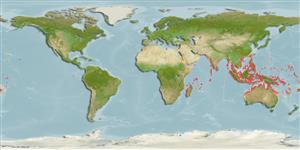Common names from other countries
Classification / Names / Names
народные названия | синонимы | Catalog of Fishes (gen., sp.) | ITIS | CoL | WoRMS
Environment: milieu / climate zone / depth range / distribution range
экология
; солоноватоводный; пределы глубины 0 - 22 m (Ref. 100692). Tropical; 26°N - 36°S, 24°E - 167°W
Indo-Pacific.
Length at first maturity / Size / Вес / Возраст
Maturity: Lm ? range ? - ? cm
Depth range is based on occurrence in Papua New Guinea (Ref. 100692); to be replaced with a better reference. It is found on the upper foliage and trunk (Ref. 112937) of mangroves R. apiculata, R. mucronata, A. alba, A. marina, S. griffithii, S. alba, L. racemosa, C. decandra, C. tagal, B. cylindrical, X. granatum, A. rontundifolia and the palm Nypa fruticans (Ref. 110211).
Life cycle and mating behavior
половая зрелость | размножение | нерест | икра | Fecundity | личинки
Members of the order Neotaenioglossa are mostly gonochoric and broadcast spawners. Life cycle: Embryos develop into planktonic trocophore larvae and later into juvenile veligers before becoming fully grown adults.
Основная ссылка
ссылки | координатор | соавторы
Smith, B.D. 2003. (Ref. 3116)
Статус Красного Списка МСОП (Ref. 130435)
Статус СИТЕС (Ref. 108899)
Not Evaluated
Not Evaluated
Угроза для людей
Harmless
Использование человеком
| FishSource |
инструменты
дополнительная информация
Возраст/Размеры
рост
Зависимость между длиной и массой тела
Зависимость между длинами
морфология
личинки
численность
ресурсы в Интернет
Estimates based on models
Preferred temperature
(Ref.
115969): 26.7 - 29.3, mean 28.7 (based on 2431 cells).
